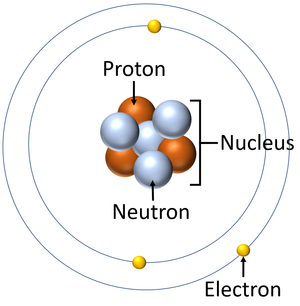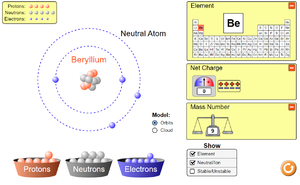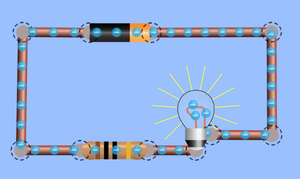Difference between revisions of "Electron"
| Line 15: | Line 15: | ||
|[[File:PhetCircuit2.png|centre|300px|link=https://phet.colorado.edu/sims/html/circuit-construction-kit-dc/latest/circuit-construction-kit-dc_en.html]] | |[[File:PhetCircuit2.png|centre|300px|link=https://phet.colorado.edu/sims/html/circuit-construction-kit-dc/latest/circuit-construction-kit-dc_en.html]] | ||
|} | |} | ||
| + | |||
| + | ==Key Stage 4== | ||
| + | ===Meaning=== | ||
| + | The [[Electron]] is a [[Negative Charge|negatively charged]] [[particle]] found [[orbit]] the [[nucleus]] of an [[atom]] in [[Electron Orbital|electron shell]]s. | ||
| + | |||
| + | ===About Electrons=== | ||
| + | : [[Electron]]s have a [[Relative Atomic Charge|relative atomic charge]] of -1 and a [[Relative Atomic Mass|relative atomic mass]] of 1/1860. | ||
Revision as of 14:12, 24 November 2018
Contents
Key Stage 3
Meaning
An electron is a small particle found orbiting the centre of an atom.
About Electrons
- Electrons negatively charged.
- In conductors electrons can pass easily from one atom to the next.
- When electrons move it is called an electrical current.
To see how electrons are arranged around the nucleus of atoms or to see how electrons move around a circuit click on the pictures below to play a PHET simulation.
Key Stage 4
Meaning
The Electron is a negatively charged particle found orbit the nucleus of an atom in electron shells.
About Electrons
- Electrons have a relative atomic charge of -1 and a relative atomic mass of 1/1860.


